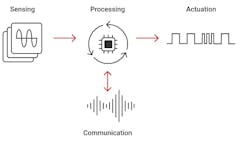Members can download this article in PDF format.
Fancy robotics are of little use if you don’t have the embedded processors and motor-control solutions to use them in a factory environment. The march toward more complex robotic systems in industrial settings increases design complexity in efforts to meet the demand for higher levels of automation.
This greater complexity is especially prevalent in robots that closely collaborate with humans, such as collaborative robots (cobots) and autonomous mobile robots (AMRs). These robots can enhance operational efficiency by enabling greater collaboration with humans and other robots while also enabling humans to focus on higher-priority tasks.
The Expanding Role of Embedded Processors
Consequently, the embedded processors in these robots must analyze and respond to a growing amount of data within the system for capabilities like perception, navigation, and motion control. By measuring the change in position of the tool with high precision via an integrated sensor system, the robot can perform complex tasks like precise assembly operations.
Too frequently, however, companies don’t have the in-house resources and expertise required to develop the hardware and software needed to fully support the robot’s processors. Even if they do, a major time investment is required to develop hardware and software resources that could be better spent on developing new products.
On top of that, the ability to process and analyze vast amounts of visual data in real-time with systems such as advanced vision-processing components help robots more reliably and safely react to split-second decisions and adapt to dynamic situations.
Even infrequent delays are unacceptable in control systems like those inside automobiles and production lines. Microcontrollers (MCUs) or controllers such as Texas Instruments’ C2000 real-time MCUs, Sitara Arm-based MCUs, integrated brushless-DC motor drives, and DC-DC controllers contain high processing capabilities that can help ensure the system meets the minimum window of time. In robotics, for example, real-time control precisely controls the position and speed of the motor, positioning a robot arm with <100-µm accuracy (Fig. 1).
Elevating System Accuracy
Such accuracy is possible through the constant measurement of motor currents and voltages, as well as the motor position. The processing unit compares the measured values with calculated values. Based on the results, the processing unit adjusts the pulse-width-modulation (PWM) signal to the motor. And the whole process needs to occur in just a few microseconds to meet the system's accuracy and timing needs.
Innovations in embedded processors and the third-party hardware that supports them will continue to push the boundaries of what's possible in robots. In applications where fractions of a second can make or break system stability, TI enables the sensing, processing, control, and communication necessary to implement and optimize real-time control.
TI's portfolio of those technologies offers power efficiency, performance, and low-latency response times to enable smaller, more reliable real-time control systems.
Multiprotocol Communications
Another tough hurdle encountered by designers is incorporating multiprotocol industrial communication with high electromagnetic compatibility and immunity for reliable operation in factory environments. Multiprotocol industrial Ethernet systems reduce manufacturing costs in the hardware development cycle, since only a single printed circuit board (PCB) needs to be fabricated, thereby also accelerating time-to-market.
These sensors, actuators, single and multiaxis drives, and programmable logic controllers (PLCs) must support industrial Ethernet protocols like EtherCAT, PROFINET, and EtherNet Industrial Protocol (EtherNet/IP), each one exchangeable by loading different software onto the hardware platform. In addition, these devices need to have high EMC immunity.
Driving Motor-Control Designs
To reduce cost and complexity, designers can work with Texas Instruments and its extensive ecosystem of third-party partners that specialize in “ready-to-deploy” hardware components. TI also provides software and design resources that help further streamline development of robotic applications. Such resources include software development kits (SDKs) and cloud-based tools for developing, benchmarking, and deploying artificial-intelligence (AI) models.
TI’s motor-control SDK is a cohesive set of software infrastructure tools and documentation designed to minimize motor-control development time (Fig. 2). The software includes firmware that runs on C2000 motor-control evaluation modules (EVMs) and TI designs (TIDs) that are targeted for industrial drives, robotics, appliances, and automotive applications.
The Motor Control SDK provides all of the needed resources at every stage of development and evaluation for high-performance motor-control applications. Embedded hardware and software engineers can gain practical knowledge on leveraging the SDK to meet the challenges of modern industrial environments.
Whether you’re developing new applications or looking to refine existing systems, the webinar “Simplifying precision motor control with TI’s Motor Control SDK” will provide valuable insights to optimize your motor-control solutions.
Conclusion
From collaborative robots working closely with humans in factories and warehouses to autonomous vehicles that can safely navigate city streets, robots will continue to transform the way our world works.
TI’s industrial-grade analog and embedded processing products help you achieve smaller single and multiaxis servo drives with high-efficiency power conversion, more accurate current, lower latency, voltage and temperature sensing, and reliable high-voltage isolation. These parts and technologies help usher in more precise designs with fast position, speed, and torque control.


